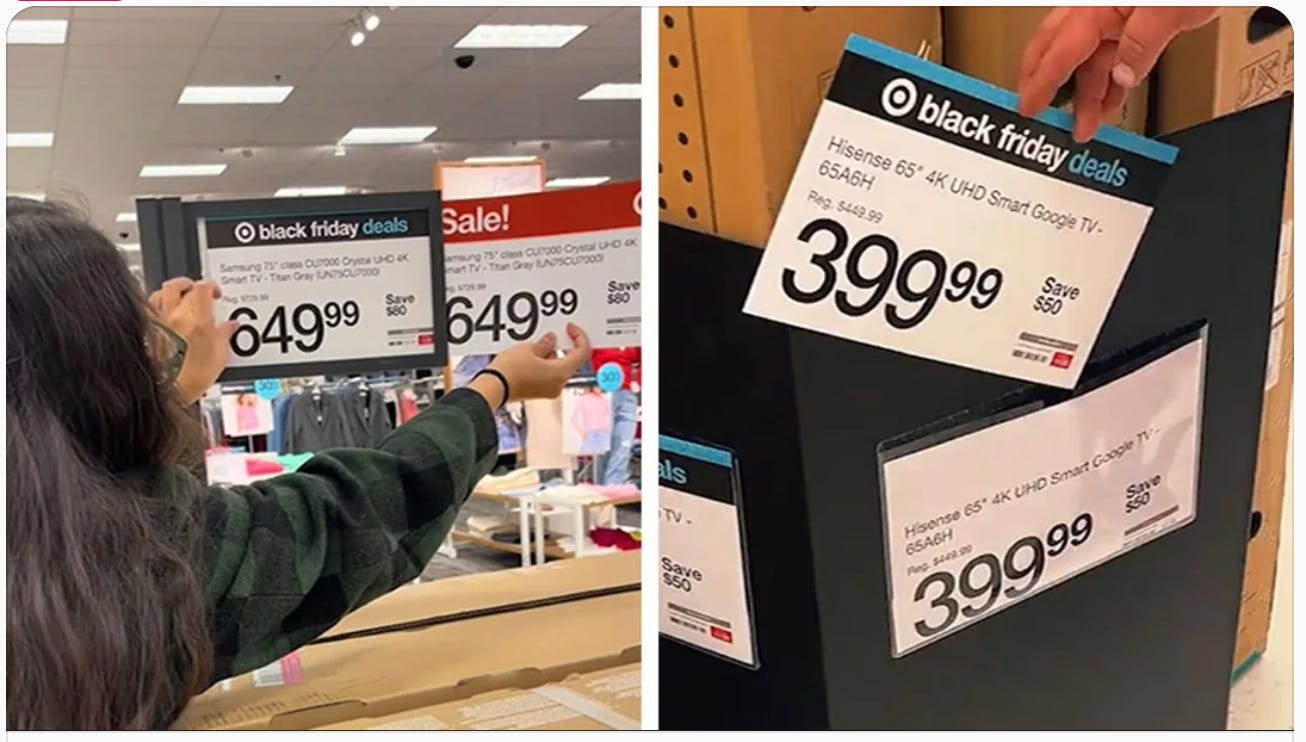This is a weekly newsletter about the art and science of building and investing in tech companies. To receive Investing 101 in your inbox each week, subscribe here:
If there's one thing most human beings are terrible at, it's estimating. We're exceptional at underestimating, or even overestimating. But when it comes to making correct estimates? The only right guess is that we'll be wrong.
One of many reasons we're so bad at this is because we have terrible heuristics. Our “rules of thumb” so often lead us astray. One key example of this is studied as part of a psychological phenomenon called the anchoring effect. The main idea is that we create anchors that inform where we start our estimations.
Sometimes these can be related. For example, if someone tells you a TV is usually priced at $300 but today its on sale for $150, you think to yourself "what a steal." $300 is your anchor, so relative to that anchor, its 50% less! But what if it turned out that TV is actually only worth $100? Your anchor led you astray.
But its also true even when things aren't related. In one experiment conducted by Dan Ariely, a professor of behavioral economics, he took a group of people. Each of them were asked to think about the last two digits of their social security number. Then, they were asked to bid on items like a bottle of wine or a box of chocolates. "The half of the group with higher two-digit numbers bid 'between 60 percent and 120 percent more' on the items." An arbitrary number, despite being completely irrelevant, can still become your anchor.
The same is true of judging people. We have all kinds of heuristics that act as our anchor for judging whether someone is a good founder, a good operator, or a good investor. Even though, quite often, those "rules of thumb" are as irrelevant as the last two digits of our social security number.
VC Talent Estimations
I've written before about how bad VCs can be at judging their quality of their co-workers:
"[VC firms] will [often] fall victim to what I call the 'little sister syndrome.' A lot of firms are quite bad at ever seeing someone as more than the junior person they hired years ago, regardless of performance or experience. That's why so many VCs don't stay at one firm, but move from firm to firm, where they can anchor at more senior positions that better match their experience.”
The "little sister syndrome" is the result of improper anchoring. Anchoring to who someone is when you first meet them will make any increase in value difficult to discern because you're still anchored to an irrelevant data point.
This is why, quite often, you see venture capitalists build their career through lateral moves rather than internal promotions. Couple of examples:
Logan Bartlett: The early days of Logan's career were built as an investor at Battery Ventures. While Logan had a stellar reputation among other investors in the know, Logan's caliber was far from widely known. Then, in 2020, he moved to Redpoint, became much more vocal on Twitter, and has now built a popular podcast, and people know how good he is. Battery didn't know what they had.
Erik Kriessmann: Erik built his career first for a few years at Khosla but then spent a long stint at Index Ventures. While there he ran Index's executive talent function and, among people in the know, Erik became one of the most networked people in venture, rubbing shoulders with some of the most exceptional executives. But it was Altimeter that gave him his shot as an investor, enabling him to utilize that network to make his own investments. Index didn't know what they had.
Sarah Wang: Sarah's career was built up grinding away at TA Associates, a PE fund. In 2019, she made the jump to a16z and, as the firm built a deeper presence in later stage investing Sarah set herself apart becoming an investor of choice for scaling tech companies. TA didn't know what they had.
Olivia & Justine Moore: Bootstrapping their venture career by building a newsletter called Accelerated, the Moore twins cut their teeth together at CRV as investors. However, the quality of their network and clarity of thought became dramatically more apparent when they became partners at a16z. CRV didn't know what they had.
Grace Isford: Grace spent long years grinding out her own investing education at Canvas, one of just a few junior people supporting the senior partners. But in 2022, Lux saw something special in Grace and gave her the opportunity to demonstrate the quality of her network in AI, and it's paid off. Canvas didn't know what they had.
I've talked to people like these and others who, after being away from their previous firm for a while, will catch up with former bosses and colleagues and have them say, "Wow! I had no idea what you were capable." Most often, that's because they were too caught up being anchored to Erik in 2019 or Grace in 2017, and didn't do a good enough job establishing a new anchor for that person.
That isn't always the case. Plenty of people have built long careers at one firm without needing to switch. My belief is that this is either because of (1) lucky circumstances of finding a mentor, specialty, and firm that coalesce around enabling that person to succeed / progress, or (2) the firm they're at has built a deliberate engine for enabling that kind of progression. Though very few firms have.
The most impressive example of this in practice I've seen is Sequoia.
The Sequoia Engine
There's a great story in The Power Law, a book about the history of venture capital. It tells the story of how Pat Grady, fresh from Summit Partners, had sourced an interesting startup in San Diego called ServiceNow.
"Grady flew to San Diego, accompanied by Doug Leone. The novice and the veteran frequently teamed up together. When they returned, they put a proposal to the partnership. Sequoia could invest $52 million for a fifth of Luddy’s firm, implying a post-money valuation of $260 million. One of Grady’s ex-Summit colleagues pushed back hard, calling the price “crazy"... Leone and Grady stood firm. Grady had identified this opportunity in the Summit way, by cold-calling the prospect. But now it was time to evaluate this opportunity in the Sequoia way and to recognize its promise. In November 2009, Sequoia duly invested. With Grady as his understudy and ally, Leone took a board seat."
Leone took the board seat, and Grady took a board observer seat. They would stand by their bet, but Leone was willing to contribute his more tenured career as a shield from any potential blow-ups.
But ServiceNow blew up in a much more positive way. "ServiceNow delivered the first ever $1 billion gain on a Sequoia growth position."
The same arm-in-arm encouragement Doug Leone offered Pat Grady had historically been given from Don Valentine to Leone, from Leone to Roelof who eventually took over the fund and, most recently, to Sonya Houang who joined Sequoia from TPG Global in 2018. I had the chance to work with Sonya on the boards of companies like Attentive and Gong. In December 2019, Sequoia led Gong's Series C. Carl Eschenbach had previously had a board seat but, in 2023, Sonya joined the board.
Once again Sequoia was deliberately executing, what the Power Law calls, a "familiar pattern" where "the unknown and homegrown had been promoted." You see the lift continuing. Pat Grady and Sonya Houang are working directly together to build their podcast, Training Data.
The Guess Behind The Curtain
VCs talk all the time about their "pattern recognition," and the magic mental model data engine that helps them "pick winners." But often investors can have their "anchor" revealed (sometimes in embarrassing ways). The better investors are the ones who can recognize that mistake and course correct. Unfortunately, the typical investor is the one who puts the blinders back over their eyes and keeps right on with their existing anchor.
It makes me think about when Walmart got caught trying to pass normal prices off as "Black Friday Sales." If they could just anchor their customers to thinking they're getting a deal, they could keep their same prices while still hopefully driving some hype. Boy, were they wrong.

"When The Facts Change"
I, like any good Buffett disciple, return often to this John Maynard Keynes quote:
“When the facts change, I change my mind - what do you do, sir?”
The little sister syndrome is a textbook example of an inaccurate anchor. This isn't just true of how VCs build their careers, though its particularly egregious in venture. It's true of how people judge talent across the board. The incorrect anchor on someone can ensure one thing: the person making the incorrect judgement will not be along for the ride when that person skyrockets.
That's why you hear so many stories of successful people who were terrible students, yet would go on to exceptional success. Structured learning, like grades and tests, were tied to the wrong anchor for that person. The correct anchor was something else entirely. Like the obsessive efforts to rebuild car engines or ham radios from scratch.
Judging the quality of a person is as much about finding the right anchor by which to estimate that person's capability as it is observing the person. Without understanding that nuance, you're doomed to lose your best people to the little sister syndrome.
Thanks for reading! Subscribe here to receive Investing 101 in your inbox each week:






Really enjoyed this post. As I have spent a lot of my time coaching I always find it fascinating how that "first anchor" is on peoples perceptions. If you get that "anchor" wrong then you head off in completely the wrong direction! Well worthy of reflection